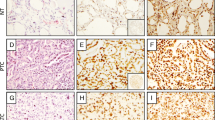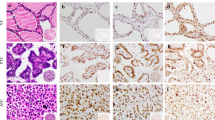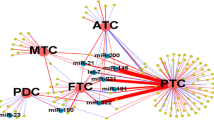Abstract
Long non-coding RNAs (lncRNAs) are important for transcription and for epigenetic or posttranscriptional regulation of gene expression and may contribute to carcinogenesis. Metastasis-associated lung adenocarcinoma transcript 1 (MALAT1), an lncRNA involved in the regulation of the cell cycle, cell proliferation, and cell migration, is known to be deregulated in multiple cancers. Here, we analyzed the expression of MALAT1 on 195 cases of benign and malignant thyroid neoplasms by using tissue microarrays for RNA in situ hybridization (ISH) and real-time PCR. MALAT1 is highly expressed in normal thyroid (NT) tissues and thyroid tumors, with increased expression during progression from NT to papillary thyroid carcinomas (PTCs) but is downregulated in poorly differentiated thyroid cancers (PDCs) and anaplastic thyroid carcinomas (ATCs) compared to NT. Induction of epithelial to mesenchymal transition (EMT) by transforming growth factor (TGF)-beta in a PTC cell line (TPC1) led to increased MALAT1 expression, supporting a role for MALAT1 in EMT in thyroid tumors. This is the first ISH study of MALAT1 expression in thyroid tissues. It also provides the first piece of evidence suggesting MALAT1 downregulation in certain thyroid malignancies. Our findings support the notion that ATCs may be molecularly distinct from low-grade thyroid malignancies and suggest that MALAT1 may function both as an oncogene and as a tumor suppressor in different types of thyroid tumors.




Similar content being viewed by others
References
Nikiforov YE, Nikiforova MN. Molecular genetics and diagnosis of thyroid cancer. Nat Rev Endocrinol. 2011;7(10):569–580.
Livolsi VA. Papillary thyroid carcinoma: an update. Mod Pathol. 2011;24(Suppl 2):S1–S9.
Li X, Wu Z, Fu X, Han W. Long Noncoding RNAs: Insights from Biological Features and Functions to Diseases. Med Res Rev. 2013;33(3):517–553.
He H, Nagy R, Liyanarachchi S, Jiao H, Li W, Suster S, et al. A Susceptibility Locus for Papillary Thyroid Carcinoma on Chromosome 8q24. Cancer Res. 2009;69(2):625–631.
He H, Li W, Liyanarachchi S, Jendrzejewski J, Srinivas M, Davuluri R V, et al. Genetic Predisposition to Papillary Thyroid Carcinoma: Involvement of FOXE1, TSHR, and a Novel lincRNA Gene, PTCSC2. J Clin Endocrinol Metab. 2015;100(1):E164–E172.
Jendrzejewski J, He H, Radomska HS, Li W, Tomsic J, Liyanarachchi S, et al. The polymorphism rs944289 predisposes to papillary thyroid carcinoma through a large intergenic noncoding RNA gene of tumor suppressor type. Proc Natl Acad Sci U S A. 2012;109(22):8646–8651.
Zhang R, Hardin H, Chen J, Guo Z, Lloyd R V. Non-Coding RNAs in Thyroid Cancer. Endocr Pathol. 2016;27(1):12–20.
Zheng H, Wang M, Jiang L, Chu H, Hu J, Ning J, et al. BRAF-activated Long Non-coding RNA Modulates Papillary Thyroid Carcinoma Cell Proliferation through Regulating Thyroid Stimulating Hormone Receptor. Cancer Res Treat. 2015;
Zhou Q, Chen J, Feng J, Wang J. Long noncoding RNA PVT1 modulates thyroid cancer cell proliferation by recruiting EZH2 and regulating thyroid-stimulating hormone receptor (TSHR). Tumour Biol. 2015;
Ma X-Y, Wang J-H, Wang J-L, Ma CX, Wang X-C, Liu F-S. Malat1 as an evolutionarily conserved lncRNA, plays a positive role in regulating proliferation and maintaining undifferentiated status of early-stage hematopoietic cells. BMC Genomics. 2011;16(676).
Buehler D, Hardin H, Shan W, Montemayor-Garcia C, Rush PS, Asioli S, et al. Expression of epithelial-mesenchymal transition regulators SNAI2 and TWIST1 in thyroid carcinomas. Mod Pathol. 2012;26(10):54–61.
Guo Z, Hardin H, Montemayor-Garcia C, Asioli S, Righi A, Maletta F, et al. In Situ Hybridization Analysis of miR-146b-5p and miR-21 in Thyroid Nodules: Diagnostic Implications. Endocr Pathol. 2015;26(2):157–163.
Huang W, Eickhoff JC, Mehraein-Ghomi F, Church DR, Wilding G, Basu HS. Expression of spermidine/spermine N1-acetyl transferase (SSAT) in human prostate tissues is related to prostate cancer progression and metastasis. Prostate. 2015;75(11):1150–1159.
Hardin H, Guo Z, Shan W, Montemayor-Garcia C, Asioli S, Yu XM, et al. The roles of the epithelial-mesenchymal transition marker PRRX1 and miR-146b-5p in papillary thyroid carcinoma progression. Am J Pathol. 2014;184(8):2342–2354.
Hardin H, Yu X-M, Harrison AD, Larrain C, Zhang R, Chen J, et al. Generation of Novel Thyroid Cancer Stem-Like Cell Clones Effects of Resveratrol and Valproic Acid. Am J Pathol. 2016;186(6):1662–1673.
Hirata H, Hinoda Y, Shahryari V, Deng G, Nakajima K, Tabatabai ZL, et al. Long noncoding RNA MALAT1 promotes aggressive renal cell carcinoma through Ezh2 and interacts with miR-205. Cancer Res. 2015;75(7):1322–1331.
Zhang Z, Weaver DL, Olsen D, Dekay J, Peng Z, Ashikaga T, et al. Long non-coding RNA chromogenic in situ hybridisation signal pattern correlation with breast tumour pathology. J Clin Pathol. 2016;69(1):76–81.
Nikiforov YE, Seethala RR, Tallini G, Baloch ZW, Basolo F, Thompson, L. D. R, et al. Nomenclature Revision for Encapsulated Follicular Variant of Papillary Thyroid Carcinoma A Paradigm Shift to Reduce Overtreatment of Indolent Tumors. JAMA Oncol. 2016;2(8):1023–1029. doi: 10.1001/jamaoncol.2016.0386.
Al-Khalaf HH, Aboussekhra A. MicroRNA-141 and microRNA-146b-5p inhibit the prometastatic mesenchymal characteristics through the RNA-binding protein AUF1 targeting the transcription factor ZEB1 and the protein kinase AKT. J Biol Chem. 2014;289(45):31433–31447.
Cancer Genome Atlas Research Network. Integrated Genomic Characterization of Papillary Thyroid Carcinoma. Cell. 2014;159(3):676–690.
Landa I, Ibrahimpasic T, Boucai L, Sinha R, Knauf JA, Shah RH, et al. Genomic and transcriptomic hallmarks of poorly differentiated and anaplastic thyroid cancers. J Clin Invest. 2016;126(3):1052–1066.
Braun J, Hoang-Vu C, Dralle H, Hutelmaier S. Downregulation of microRNAs directs the EMT and invasive potential of anaplastic thyroid carcinomas. Oncogene. 2010;29(29):4237–4244.
Visone R, Pallante P, Vecchione A, Cirombella R, Ferracin M, Ferraro A, et al. Specific microRNAs are downregulated in human thyroid anaplastic carcinomas. Oncogene. 2007;26(54):7590–7595.
Huang J-K, Ma L, Song W-H, Lu B-Y, Huang Y-B, Dong H-M, et al. MALAT1 promotes the proliferation and invasion of thyroid cancer cells via regulating the expression of IQGAP1. Biomed Pharmacother. 2016;83:1–7.
Acknowledgments
We kindly thank Dr. Daniel T. Ruan (Brigham and Women’s Hospital, Boston, MA) for the TPC1 cell line and the staffs of the Translational Research in Pathology (TRIP) (University of Wisconsin Carbone Cancer Center Cancer Center Support Grant P30 CA014520) for their services. Dr. Ranran Zhang received a research grant from the Department of Pathology and Laboratory Medicine, University of Wisconsin School of Medicine and Public Health.
Author information
Authors and Affiliations
Corresponding author
Ethics declarations
The study was approved by the Institutional Review Board at the University of Wisconsin–Madison.
Conflict of Interest
The authors declare that they have no conflict of interest.
Additional information
Presented as a Poster Session at the 105th Meeting of the US and Canadian Academy of Pathology in Seattle, WA, 2016.
Rights and permissions
About this article
Cite this article
Zhang, R., Hardin, H., Huang, W. et al. MALAT1 Long Non-coding RNA Expression in Thyroid Tissues: Analysis by In Situ Hybridization and Real-Time PCR. Endocr Pathol 28, 7–12 (2017). https://doi.org/10.1007/s12022-016-9453-4
Published:
Issue Date:
DOI: https://doi.org/10.1007/s12022-016-9453-4




